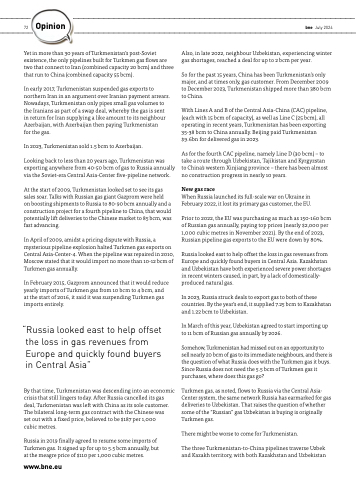Page 72 - bne_July 2024_20240709
P. 72
72 Opinion
bne July 2024
Yet in more than 30 years of Turkmenistan’s post-Soviet existence, the only pipelines built for Turkmen gas flows are two that connect to Iran (combined capacity 20 bcm) and three that run to China (combined capacity 55 bcm).
In early 2017, Turkmenistan suspended gas exports to northern Iran in an argument over Iranian payment arrears. Nowadays, Turkmenistan only pipes small gas volumes to the Iranians as part of a swap deal, whereby the gas is sent in return for Iran supplying a like amount to its neighbour Azerbaijan, with Azerbaijan then paying Turkmenistan
for the gas.
In 2023, Turkmenistan sold 1.5 bcm to Azerbaijan.
Looking back to less than 20 years ago, Turkmenistan was exporting anywhere from 40-50 bcm of gas to Russia annually via the Soviet-era Central Asia-Center five-pipeline network.
At the start of 2009, Turkmenistan looked set to see its gas sales soar. Talks with Russian gas giant Gazprom were held
on boosting shipments to Russia to 80-90 bcm annually and a construction project for a fourth pipeline to China, that would potentially lift deliveries to the Chinese market to 85 bcm, was fast advancing.
In April of 2009, amidst a pricing dispute with Russia, a mysterious pipeline explosion halted Turkmen gas exports on Central Asia-Center-4. When the pipeline was repaired in 2010, Moscow stated that it would import no more than 10-12 bcm of Turkmen gas annually.
In February 2015, Gazprom announced that it would reduce yearly imports of Turkmen gas from 10 bcm to 4 bcm, and at the start of 2016, it said it was suspending Turkmen gas imports entirely.
“Russia looked east to help offset the loss in gas revenues from Europe and quickly found buyers in Central Asia”
By that time, Turkmenistan was descending into an economic crisis that still lingers today. After Russia cancelled its gas deal, Turkmenistan was left with China as its sole customer. The bilateral long-term gas contract with the Chinese was
set out with a fixed price, believed to be $187 per 1,000 cubic metres.
Russia in 2019 finally agreed to resume some imports of Turkmen gas. It signed up for up to 5.5 bcm annually, but at the meagre price of $110 per 1,000 cubic metres.
www.bne.eu
Also, in late 2022, neighbour Uzbekistan, experiencing winter gas shortages, reached a deal for up to 2 bcm per year.
So for the past 15 years, China has been Turkmenistan’s only major, and at times only, gas customer. From December 2009 to December 2023, Turkmenistan shipped more than 380 bcm to China.
With Lines A and B of the Central Asia-China (CAC) pipeline, (each with 15 bcm of capacity), as well as Line C (25 bcm), all operating in recent years, Turkmenistan has been exporting 35-38 bcm to China annually. Beijing paid Turkmenistan $9.6bn for delivered gas in 2023.
As for the fourth CAC pipeline, namely Line D (30 bcm) – to take a route through Uzbekistan, Tajikistan and Kyrgyzstan to China's western Xinjiang province – there has been almost no construction progress in nearly 10 years.
New gas race
When Russia launched its full-scale war on Ukraine in February 2022, it lost its primary gas customer, the EU.
Prior to 2022, the EU was purchasing as much as 150-160 bcm of Russian gas annually, paying top prices (nearly $2,000 per 1,000 cubic metres in November 2021). By the end of 2023, Russian pipeline gas exports to the EU were down by 80%.
Russia looked east to help offset the loss in gas revenues from Europe and quickly found buyers in Central Asia. Kazakhstan and Uzbekistan have both experienced severe power shortages in recent winters caused, in part, by a lack of domestically- produced natural gas.
In 2023, Russia struck deals to export gas to both of these countries. By the year’s end, it supplied 7.25 bcm to Kazakhstan and 1.22 bcm to Uzbekistan.
In March of this year, Uzbekistan agreed to start importing up to 11 bcm of Russian gas annually by 2026.
Somehow, Turkmenistan had missed out on an opportunity to sell nearly 20 bcm of gas to its immediate neighbours, and there is the question of what Russia does with the Turkmen gas it buys. Since Russia does not need the 5.5 bcm of Turkmen gas it purchases, where does this gas go?
Turkmen gas, as noted, flows to Russia via the Central Asia- Center system, the same network Russia has earmarked for gas deliveries to Uzbekistan. That raises the question of whether some of the “Russian” gas Uzbekistan is buying is originally Turkmen gas.
There might be worse to come for Turkmenistan.
The three Turkmenistan-to-China pipelines traverse Uzbek and Kazakh territory, with both Kazakhstan and Uzbekistan


